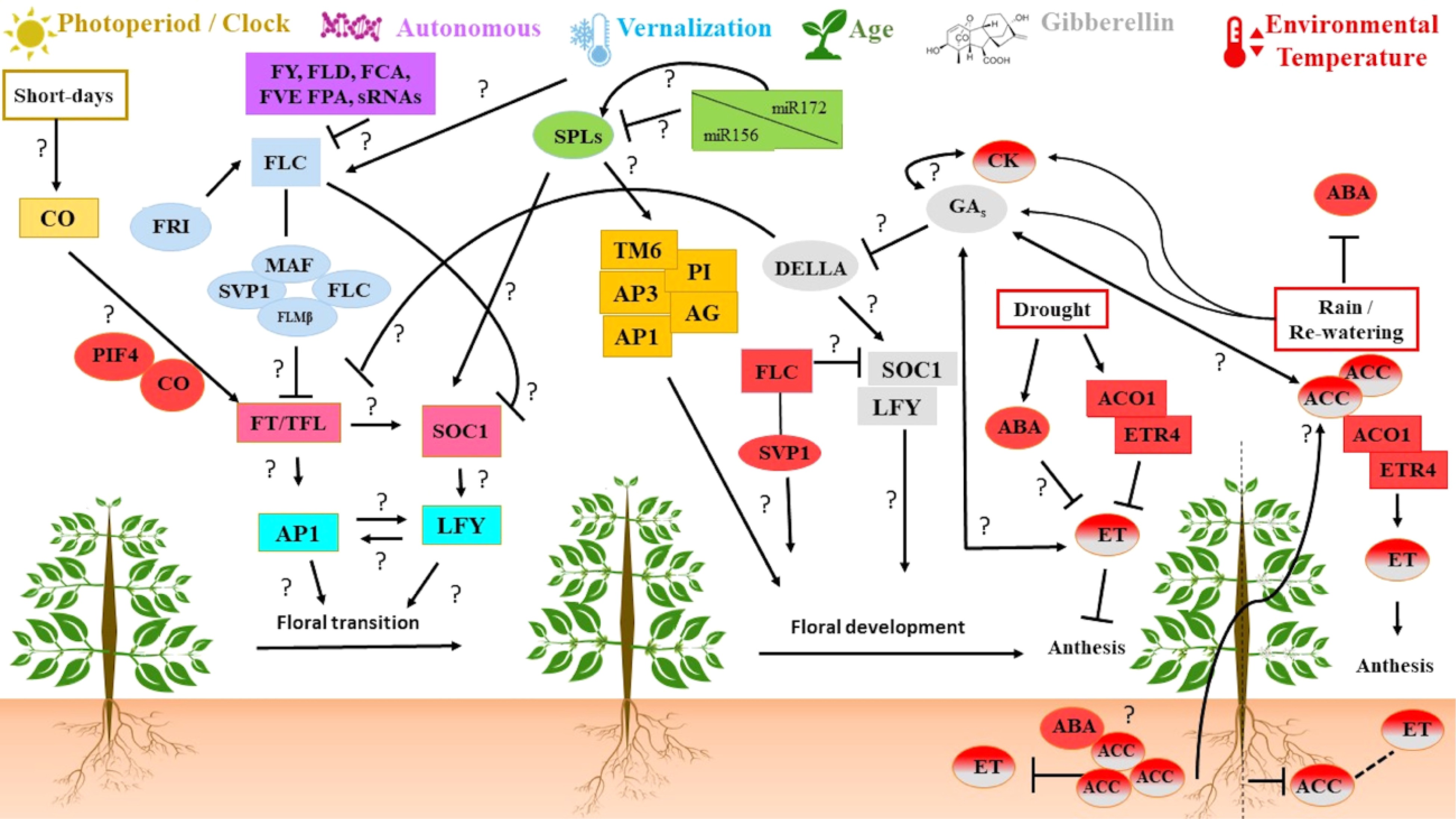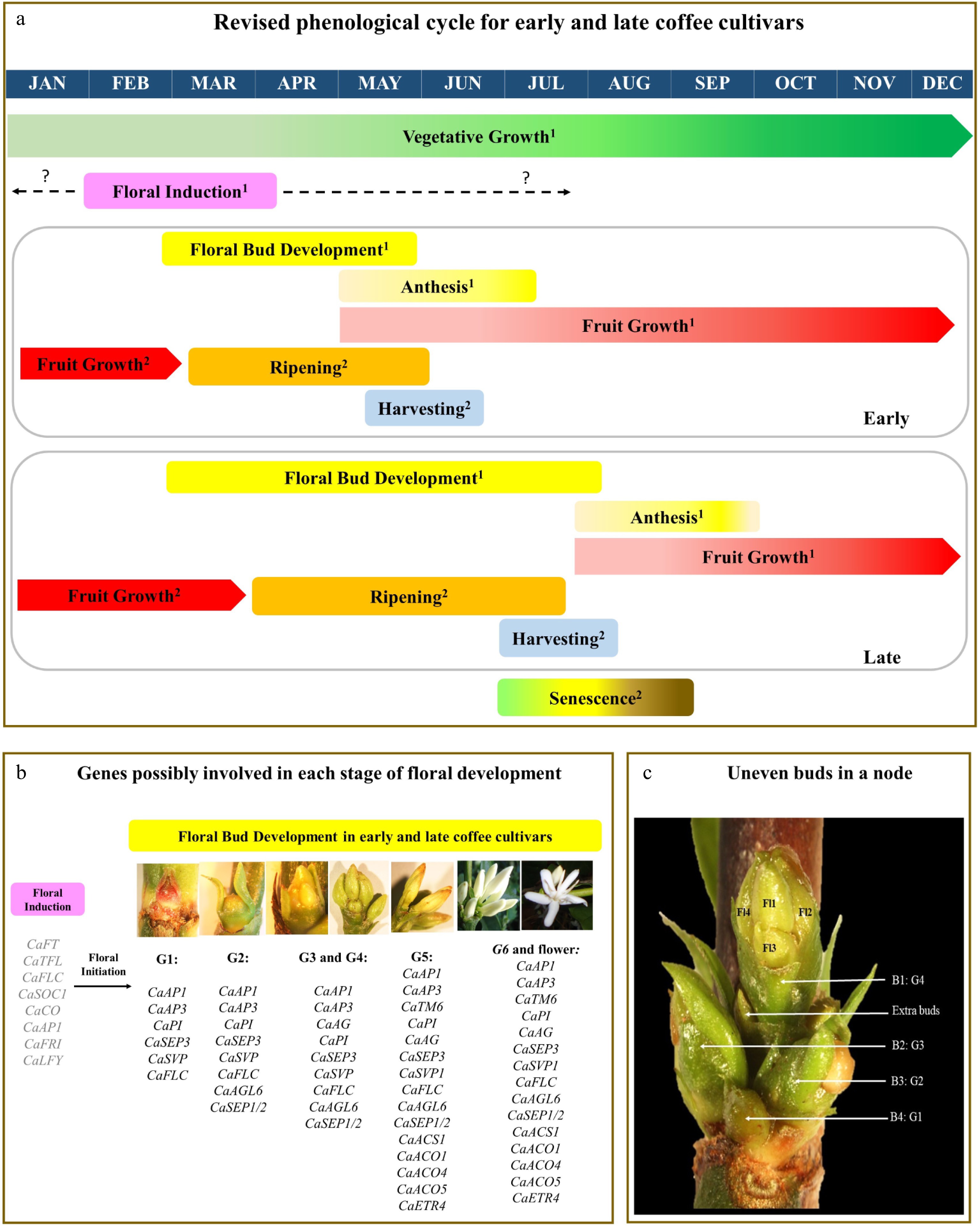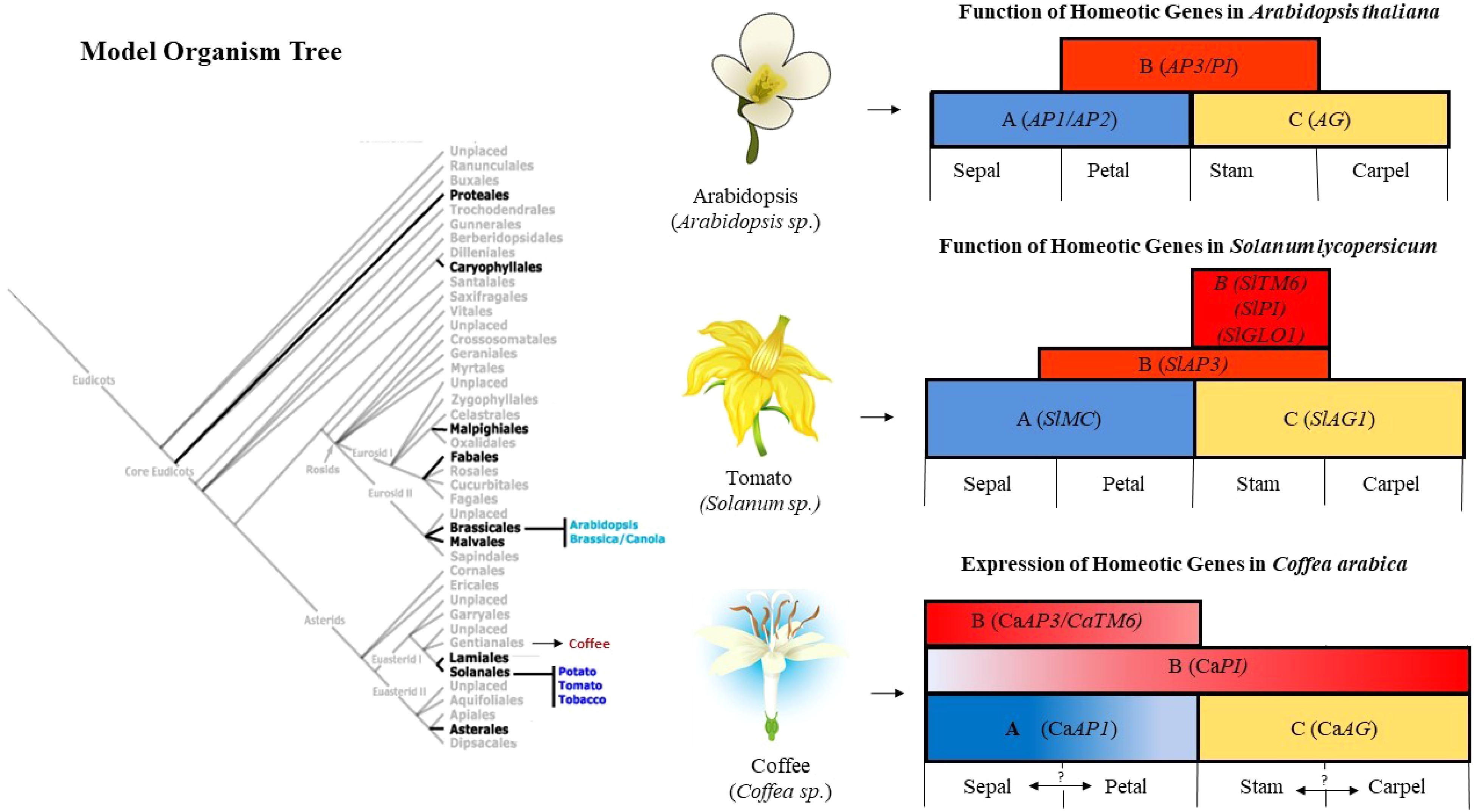-

Figure 1. Summary of molecular pathways possibly involved in the flowering time and developmental processes in C. arabica: photoperiod/clock (yellow), autonomous (purple), vernalization (sky blue), age (green), gibberellin (gray), and environmental temperature (red). Pink boxes represent the main floral integrator genes. Light blue boxes represent the inflorescence meristem identity genes. Orange boxes represent the homeotic genes. Squared boxes represent genes having a pivotal role in the specific pathway. Circles represent several proteins or complexes. Solid lines indicate induction, dashed lines indicate no significant change in the relative amount and, the T end to the arrows indicate decreases. Interrogations indicate connections proposed in this review based on previous studies found in the literature for other species, but not confirmed for coffee. Relationships involving environmental changes associated with water (drought, rain, irrigation, re-watering) are connected in the environmental temperature pathway. The red and gray gradient in the circles indicates a possible interaction between the pathways. ABA: abscisic acid, ACC: 1-aminocyclopropane-1-carboxylic acid, ACO: 1-aminocyclopropane-1-carboxylic acid oxidase AG: AGAMOUS, AP1: APETALA 1, AP3: APETALA 3, CK: CYTOKININ, CO: CONSTANS, ET: ETHYLENE, ETR4: ETHYLENE RECEPTOR 4, FCA: FLOWERING LOCUS CA, FLC: FLOWERING LOCUS C, FLD: FLOWERING LOCUS D, FLM: FLOWERING LOCUS M, FPA: FLOWERING LOCUS PA, FRI: FRIGIDA, FVE: FLOWERING LOCUS VE, FY: FLOWERING LOCUS Y, GA: GIBBERELLIN, LFY: LEAFY, MAF: MADS AFFECTING FLOWERING PI: PISTILLATA, PIF4: PHYTOCHROME INTERACTING FACTOR 4, SOC1: SUPPRESSOR OF OVEREXPRESSION OF CONSTANS 1, SPL: SQUAMOSA PROMOTER-BINDING PROTEIN, sRNAs: SMALL RNAs, SVP: SHORT VEGETATIVE PHASE, TFL: TERMINAL FLOWER, TM6: TOMATO MADS BOX GENE 6.
-

Figure 2. Proposed model for the induction and floral C. arabica development under Brazilian environmental conditions. (a) Revised model for vegetative and reproductive development in C. arabica cultivars regarding flowering time: early and late cultivars. The intensity of vegetative growth (leaf bud formation) for the two cultivars is shown by the gradient in the color of the green box. Floral induction (pink box) described in the literature between February and April is proposed to start in January, extending until July for early and late cultivars. The period of floral development (yellow box) is contrasting between cultivars, lasting 3 months in the early cultivar and 5 months in the late cultivar. Shortening in floral development stages in the early cultivar promotes anticipation of anthesis (the yellow box with gradient: light yellow indicates less intense flowering and dark yellow indicates greater or main flowering). While the late cultivar starts the lesser intensity flowering, the early cultivar advances in fruit growth (red box). Fruit development stages (pinhead, expansion, graining) for both cultivars end at the beginning of the second phenological year, followed by fruit ripening and harvesting. Self-pruning is shown as the progress from senescence to death of tertiary and quaternary branches (box with green to black color gradient). A dashed arrow suggests change at the beginning and end of the respective phase. Interrogation indicates an unproven relationship. Superscript numbers indicate the first (1) or second (2) year in the coffee tree's phenological cycle. (b) Genes are possibly involved in each stage of floral development in C. arabica. The floral induction process involves the activation of genes by environmental and endogenous pathways related to the differentiation of the Stem Apical Meristem (SAM) reproductive meristem. Then, flower initiation is initiated by combining flower organ identity genes related to the specification of whorls in floral buds. In the G5 and G6 stages, genes of the ethylene pathway (CaACS1, CaACO1, CaACO4, CaACO5) are related to opening flower progress. Genes in gray represent the connection suggested in this review and genes in black are proposed based on the quantitative and qualitative gene expressions found in the literature[13,32,33]. (c) Photo describing the uneven development of floral buds in a node located on the branch of a coffee plant. Four floral buds (B1, B2, B3, B4) are shown in ascending order of emergence with the respective identification of developmental stages (G4, G3, G2, G1[7]). In the floral bud B1 are indicated the four flowers (Fl) that finish its development with the anthesis. Thus, each node can potentially produce 16 flowers (four flowers from each bud[13]), but B3 and B4 commonly remain latent and, in some cases, extra floral buds can be developed, as identified in this photo.
-

Figure 3. Proposed ABC model for floral organ identity in C. arabica. Left, phylogenetic classification of eudicots orders highlighting the model organisms (adapted from Geuten & Irish[167], which shows the relationship between the three species compared: Arabidopsis thaliana, C. arabica, and Solanum lycopersicum. A schematic representation of the respective flowers of the compared species is shown in the center. Right, variations of the ABC model explaining floral organ differentiation are represented. The ABC model of Arabidopsis thaliana guides the investigation of orthologous homeotic genes in flowering species, in which the variation in the ABC model may occur due to cumulative differences along evolutionary time in sequences, expression patterns, and/or combination of these genes for the specification of the four floral whorls. The ABC model for Arabidopsis thaliana and Solanum lycopersicum was built considering the functional analysis in mutant plants for specification floral organs[168−171]. For C. arabica, the ABC model is proposed based on the quantitative and qualitative gene expression[162]. The gradient color indicates the highest, lowest, or absent (white) expression of class A, B, and C genes in the initial, intermediate and final developmental phases of each floral whorl.
Figures
(3)
Tables
(0)